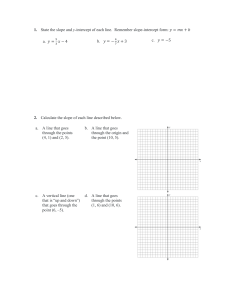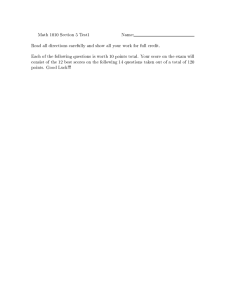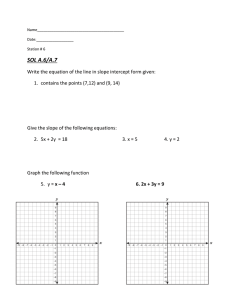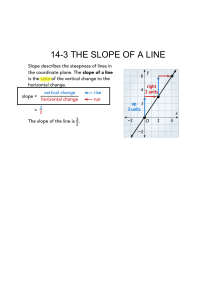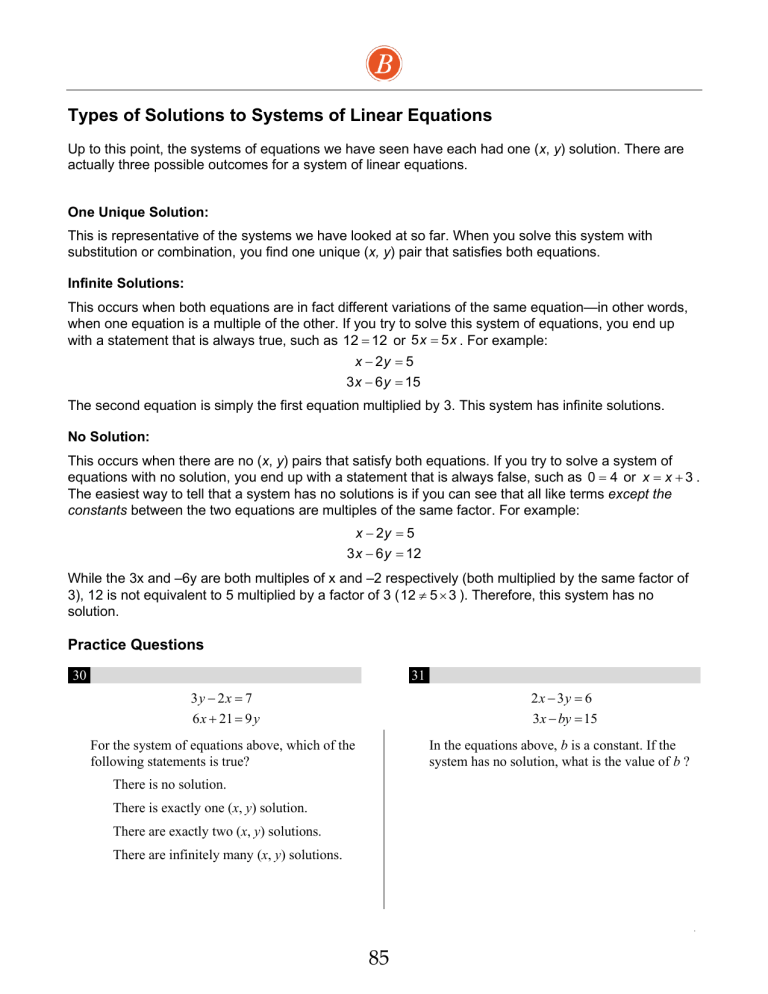
Types of Solutions to Systems of Linear Equations Up to this point, the systems of equations we have seen have each had one (x, y) solution. There are actually three possible outcomes for a system of linear equations. (We explore this in more detail in the lesson on graphing lines in the coordinate plane on page 297.) One Unique Solution: This is representative of the systems we have looked at so far. When you solve this system with substitution or combination, you find one unique (x, y) pair that satisfies both equations. Infinite Solutions: This occurs when both equations are in fact different variations of the same equation—in other words, when one equation is a multiple of the other. If you try to solve this system of equations, you end up with a statement that is always true, such as 12 = 12 or 5 x = 5 x . For example: x − 2y = 5 3 x − 6 y = 15 The second equation is simply the first equation multiplied by 3. This system has infinite solutions. No Solution: This occurs when there are no (x, y) pairs that satisfy both equations. If you try to solve a system of equations with no solution, you end up with a statement that is always false, such as 0 = 4 or x = x + 3 . The easiest way to tell that a system has no solutions is if you can see that all like terms except the constants between the two equations are multiples of the same factor. For example: x − 2y = 5 3 x − 6 y = 12 While the 3x and –6y are both multiples of x and –2 respectively (both multiplied by the same factor of 3), 12 is not equivalent to 5 multiplied by a factor of 3 ( 12 5 3 ). Therefore, this system has no solution. Practice Questions 30 31 3y − 2x = 7 2x − 3 y = 6 6 x + 21 = 9 y 3x − by = 15 For the system of equations above, which of the following statements is true? In the equations above, b is a constant. If the system has no solution, what is the value of b ? A) There is no solution. B) There is exactly one (x, y) solution. C) There are exactly two (x, y) solutions. D) There are infinitely many (x, y) solutions. 242 85 10 Modeling Systems of Linear Equations, continued Example 2: a = 5.30 + .55x b = 2.90 + 1.15x In the equations above, a and b represent the total price of smartphone apps A and B, respectively, after x in-app purchases. For how many in-app purchases would the total prices of both apps be the same? What is this total price? Step 1: The variables are already defined for you, so your task is to figure out how the two equations are connected. If we are looking for when the total prices are the same, we can set a and b equal to each other. Step 2: Solve: 5.30 + .55 x = 2.90 + 1.15 x 2.40 = .60x 4=x Step 3: Make sure you are answering the question. The number of in-app purchases for which the prices of both apps would be the same is 4. To find the total price, substitute 4 into one of the equations. As expected, they will both give you the same number. 5.30 + .55(4) = 7.5 2.90 + 1.15(4) = 7.5 Both apps have a price of $7.50 when used with 4 in-app purchases. Exercise: Milo is offered freelance writing work at two different magazines. Magazine A offers to pay $25 per hour, plus a bonus of $400 when the job has been completed. Magazine B offers to pay $35 per hour, plus a bonus of $150 when the job has been completed. a. Write an equation representing Milo’s pay for Magazine A. ____________________________________________________ b. Write an equation representing Milo’s pay for Magazine B. ____________________________________________________ c. Write an equation that could be used to determine the number of hours Milo would need to work for his pay from Magazine A to equal his pay from Magazine B. ____________________________________________________ 271 86 11 Coordinate Geometry On the SAT, you will need to be able to connect algebraic ideas to graphs on the coordinate plane. For Heart of Algebra questions, you will need to be familiar with graphs of linear equations and linear inequalities. The xy-Coordinate Plane Coordinate geometry questions on the SAT involve two-dimensional geometry and take place on a coordinate plane formed by two perpendicular number lines. The horizontal line is called the x-axis and the vertical line is called the y-axis. The location of a point is denoted by its position relative to the x- and y-axes. The x-coordinate is always first, followed by the y-coordinate. An easy way to remember this is that they are in alphabetical order (x, y). y Note that these two axes divide the graph into four quadrants, which are referred to as quadrants I, II, III, and IV, as shown on the right. Exercise: a. What are the coordinates of point A? ________ b. If point B (not shown) has coordinates (4, –3), in what quadrant does point B lie? ________ II A 6 5 4 3 2 1 -6 -5 -4 -3 -2 1-1 -2 -3 -4 -5 III -6 I 1 2 3 4 5 6 x IV c. Plot the points (–4, –3) and (2, –1) in the coordinate plane below. Then draw a line passing through these two points and extending forever in both directions. y 6 5 4 3 2 1 -6 -5 -4 -3 -2 1-1 -2 -3 -4 -5 -6 1 2 3 4 5 6 x d. Which quadrant(s) contain(s) no points on the line? ________ Note: Answers to all the questions and exercises in this chapter are found in the answer key on page 319. 294 87 12 Slope Many SAT questions involve graphing a line on the coordinate plane. The slope of a line is basically a measure of how steep it is. The formula for slope is sometimes referred to as “rise over run” because it requires dividing the vertical change of the line by its horizontal change. If you know two points on a line, (x1, y1) and (x2, y2), you can find its slope m using the formula: m= rise y 2 − y1 = run x2 − x1 Sometimes you can simply count the rise and the run if you are given a graph, but often you will need to use the formula. You can plug any two points on the line into the formula; the slope will always be the same. It also doesn’t matter which point you call (x1, y1) and which (x2, y2). Just be sure to maintain the same order of coordinates in the numerator as in the denominator. You may find it helpful to label your points before starting the problem. Exercise: y run of 4 6 a. What is the slope of the line on the right? ________ rise of 6 5 4 3 2 1 -6 -5 -4 -3 -2 1-1 -2 (-3, -2) -3 -4 -5 -6 b. What is the slope of a line passing through the points (4, 3) and (7, –9) ? ________ (1, 4) 1 2 3 4 5 6 x Practice Questions 1 2 If the slope of the line that passes through the 1 points (n, 0) and (1, –2) is , what is the value 2 of n ? If a line in the xy-plane contains the points (1, 1) and (2, 4), it also contains which of the following points? A) (–3, –6) B) (–2, –8) C) (0, 0) D) (3, 9) Tip: The slope between any two points on the same line must be the same. 295 88 13 Positive and Negative Slope The orientation of a line tells you whether its slope is positive or negative. • A line that slants upward from left to right has a positive slope. y Line 1 6 5 4 3 2 1 -6 -5 -4 -3 -2 1-1 -2 -3 -4 -5 -6 • A line that slants downward from left to right has a negative slope. Line 2 • A flat or horizontal line has a slope of zero. • A vertical line has an undefined slope. 1 2 3 4 5 6 x • If a line with slope m forms an angle of 45º with the x-axis, then m = 1 . • The steeper the line, the larger the absolute value of the slope. a. Line 1 has a ______________ slope. b. Line 2 has a ______________ slope. Practice Questions 3 4 y y 6 5 4 3 2 1 -6 -5 -4 -3 -2 1-1 -2 -3 -4 -5 -6 1 2 3 4 5 6 6 5 4 3 2 1 x -6 -5 -4 -3 -2 1-1 -2 -3 -4 -5 -6 1 2 3 4 5 6 x What is the slope of the line graphed in the xyplane above? A line with slope m is shown in the graph above. Which of the following statements is true? A) –3 A) m −1 B) − C) B) −1 m 0 1 3 C) 0 m 1 1 3 D) m 1 D) 3 14 296 89

